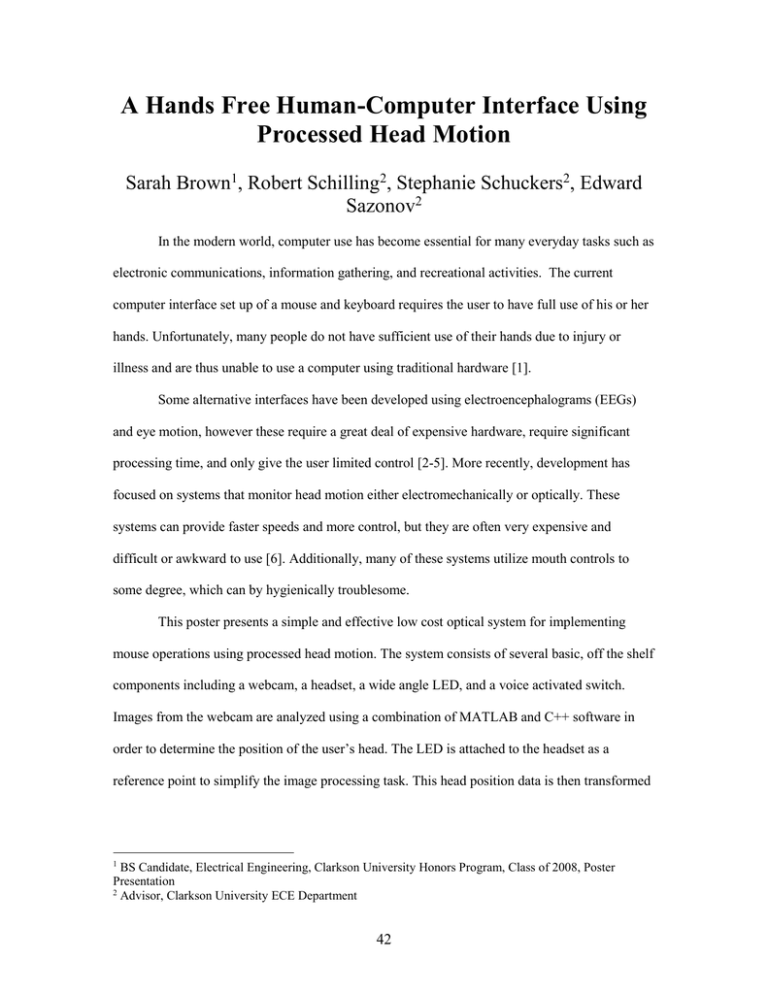A Hands Free Human-Computer Interface Using Processed Head Motion Sarah Brown
advertisement

A Hands Free Human-Computer Interface Using Processed Head Motion Sarah Brown1, Robert Schilling2, Stephanie Schuckers2, Edward Sazonov2 In the modern world, computer use has become essential for many everyday tasks such as electronic communications, information gathering, and recreational activities. The current computer interface set up of a mouse and keyboard requires the user to have full use of his or her hands. Unfortunately, many people do not have sufficient use of their hands due to injury or illness and are thus unable to use a computer using traditional hardware [1]. Some alternative interfaces have been developed using electroencephalograms (EEGs) and eye motion, however these require a great deal of expensive hardware, require significant processing time, and only give the user limited control [2-5]. More recently, development has focused on systems that monitor head motion either electromechanically or optically. These systems can provide faster speeds and more control, but they are often very expensive and difficult or awkward to use [6]. Additionally, many of these systems utilize mouth controls to some degree, which can by hygienically troublesome. This poster presents a simple and effective low cost optical system for implementing mouse operations using processed head motion. The system consists of several basic, off the shelf components including a webcam, a headset, a wide angle LED, and a voice activated switch. Images from the webcam are analyzed using a combination of MATLAB and C++ software in order to determine the position of the user’s head. The LED is attached to the headset as a reference point to simplify the image processing task. This head position data is then transformed 1 BS Candidate, Electrical Engineering, Clarkson University Honors Program, Class of 2008, Poster Presentation 2 Advisor, Clarkson University ECE Department 42 using a non-linear transformation into a corresponding screen position that is used to control the mouse pointer. Clicking operations are accomplished using the voice activated switch. This system was tested on small group of subjects. Each subject first completed a short calibration procedure in order to build an accurate transformation matrix. He or she was then trained on the use of the system using a simple icon selection task. Once the subject was comfortable using the system, he or she completed a series of simple day to day tasks including icon selection, typing using the on-screen keyboard, and web browsing. As a reference, each subject also completed the same tasks using a traditional mouse. In the icon selection task, the subjects had an average decrease in throughput of 2.63 bits/s, or 76.6%, when using the head mouse system instead of a manual mouse. The decrease in accuracy, however, was small with an average decrease of approximately 11%. The typing and web browsing tasks showed similar results, with speeds decreasing by 68.1% and 84.3%, respectively. Future work on this system includes the integration of speech recognition using Microsoft’s Speech Software Development Kit. This more advanced speech recognition should allow for more advanced clicking operations such as right clicking, dragging and dropping, and double clicking. Additionally, increased typing speed could be achieved using speech-based text entry. Works Cited [1] S. Trewin and H. Pain, “A model of keyboard configuration requirements,” Behav. Inform Technol., vol 18, no 1, pp. 27-35, 1999. [2] G. A. Rinard, R. W. Matteson, R. W. Quine, and R. S. Tegtmeyer, “An infrared system for determining ocular position,” ISA Trans, vol. 19, no. 4, pp. 3-6, 1980. [3] N. Gravil, P. A. Griffiths, R. Potter, and A. Yates, “Eye control of microcomputer,” Comput. Bull. Serial, vol. 3, pp. 15-16, 1985. [4] J. R. Lacourse and F. C. Hladik, Jr., “An eye movement communication-control system for the disabled,” IEEE Eng. Med. Biol. vol. 37, pp. 1215-1220, Dec. 1990. [5] Z. A. Keirn and J. I. Aunon, “Man-machine communications through brain wave processing,” IEEE Eng. Med. Biol., pp. vol. 37, pp. 1215-1220, 1990. [6] D. G. Evans, R. Drew and P. Blenkhorn, “Controlling mouse pointer position using an infrared head-operated joystick,” IEEE Trans. Rehab. Eng., vol. 8, no. 1, pp. 107-117, 2000. 43

